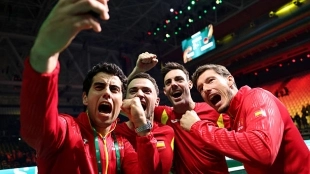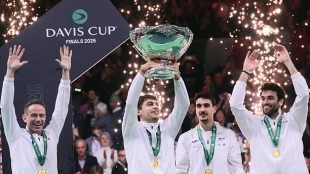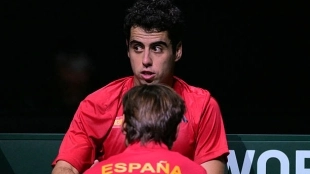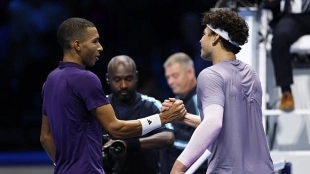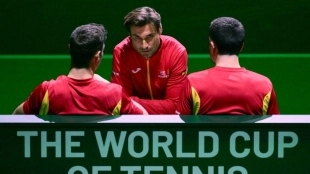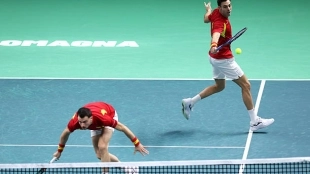
Turin put an end to the ATP 2025 season with the most repeated final throughout the year: Carlos Alcaraz vs Jannik Sinner. It was the fastest court they were going to face each other on, with favoritism for the Italian, who applied the right tactics after what happened in the US Open final. Although Carlitos was in great shape, he couldn't execute everything he wanted.
The fact that Alcaraz is the only one who can stop Sinner is based on the Murcian's ability to vary the pace of play like no one else. Unlike the rest, Carlitos is able to defend within the high pace that Jannik imposes, varying the game with high or sliced shots, taking the Italian out of his comfort zone.
On clay, Carlos moves him with high balls that force him to hit at an awkward height or pushes him back with his powerful spin, and on other surfaces, he can apply the slice or drop shots, moving him away from his comfort zone. Therefore, on a court like Turin, Carlos needed to be much more aggressive if he wanted to trouble Sinner.
In the ATP Finals, Carlitos would have less time to vary his game. On this court, he couldn't hit high or heavy balls, as the bounce would be low. Perhaps he could apply a bit more slice to change the rhythm, but above all, the idea had to be to move forward and be offensive, taking the initiative with net approaches or dominating with his forehand. However, Jannik came with a well-learned and perfectly executed strategy.
Sinner's Perfect Tactics
After losing the US Open final, where Sinner couldn't even come close tactically due to Alcaraz's strategy, he was determined not to allow the Spaniard to harm him in any way. Therefore, he wanted to implement different moves to prevent Carlos from varying his game.
The first strategy was to go for the second serves. Alcaraz was going to attack Sinner's second serves and put pressure on him that way. Thus, the Italian didn't mind accumulating more double faults than usual. He was willing to accept finishing the match with 5-6 double faults, in exchange for preventing Carlos from dominating from the return. The result? Sinner avoided a torrent of return attacks from Alcaraz.
In fact, Carlos repeatedly struggled with Jannik's second serve, to the extent of changing his return position against the second serves, making a mistake in his approach, as out of the seven times he moved back, he only won the point on two occasions. In a match decided by a few points, losing five out of seven was a significant weight in the match balance.

Contact point for Alcaraz with second serves: highlighting the five balls lost when he returned 5-6 meters back
It's worth mentioning that Jannik didn't have his best day on serve. Unlike his first four matches in the ATP Finals, where he served his top four matches of the year, he had a rather normal day on serve. Yet, he managed to outplay Carlos in the battle from the baseline.
The most repeated gameplay pattern was the crosscourt backhand. There, Sinner outperformed Carlos, positioning himself in a winning position much more often than the Spanish player, but in the battle of crosscourt forehands where Alcaraz should have excelled, Jannik dominated him.
The Italian had one thing very clear: he had to crush the forehand. And he did exactly that. He played one of his best matches all year with this shot, achieving an average rating of 9.7 in the second set. That is, he was nearly flawless. He hit hard and deep, making it difficult for Alcaraz to have time to set up his forehand or push the Italian back or change the game.
In other words, Jannik didn't let himself be dominated. He hit long and powerful with his forehand and was very accurate in doing so. As a result, Carlos couldn't execute the strategy he wanted to trouble Sinner and vary the game. Simply put, the Italian didn't allow him to execute his game plan.

Sinner's gameplay pattern against Alcaraz: highlighting the deep shots with his crosscourt forehand and backhand. Carlos always found the ball too close
Feeling pressured, it's no wonder Carlos resorted to . In fact, Alcaraz finished the match with a statistic totally uncharacteristic of him, as he ended up with more points lost at the net (8) than won (7), indicating that his net approaches were poor, prompted by a Jannik who hit precisely and aggressively down the line.
Carlos did almost everything perfectly, being very offensive, hitting more forehands (113) than backhands (79), but fell a bit short in returning second serves and relieving pressure on the forehand side.
In addition, Sinner was much more precise in both attack and defense. In the second set, he converted 78% of his attacking opportunities, compared to only 57% for Carlos. And in defense, the Italian converted 21% more than the Spaniard. In other words, Jannik attacked and defended better than his main rival.

Second set: Sinner won more points against Carlos in defense and converted more attacking shots
With these factors, Sinner's victory was assured. Despite everything, Carlitos came very close, as everything was decided by small details, but in a match like this and on a fast-paced court, a couple of points here and there tip the scale. Carlos was at a 9, but his problem was that Sinner was almost at a 10. To beat Jannik on a court like this, everything has to be done perfectly. Surely, he will have noted what was missing last Sunday for the next time.
Data source: Insights, by TennisViz.
This news is an automatic translation. You can read the original news, La táctica secreta de Sinner para pillar desprevenido a Alcaraz en la final de Turín







